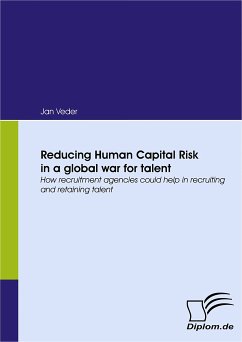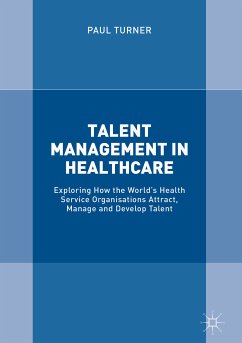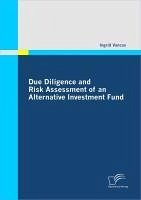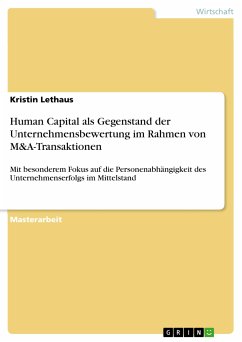
Reducing Human Capital Risk in a global war for talent (eBook, PDF)
How recruitment agencies could help in recruiting and retaining talent
Versandkostenfrei!
Sofort per Download lieferbar
Statt: 38,00 €**
33,00 €
inkl. MwSt. und vom Verlag festgesetzt.
**Preis der gedruckten Ausgabe (Broschiertes Buch)
Alle Infos zum eBook verschenkenWeitere Ausgaben:

PAYBACK Punkte
0 °P sammeln!
It was in 1982 as the oil price reached more than a hundred dollar a barrel for the first time. The limit of resources and the vulnerability of economies were then discussed widely in the public as it is today. Stock prices were affected heavily due to the economical risks a high priced commodity exposes to shareholders. In a few years time, a similar scenario seems to be possible for Human Resources. A company's availability to recruit and to retain key talent could have the same or an even higher impact on investor's expectations in the future. This study examines actual ways Human Capital R...
It was in 1982 as the oil price reached more than a hundred dollar a barrel for the first time. The limit of resources and the vulnerability of economies were then discussed widely in the public as it is today. Stock prices were affected heavily due to the economical risks a high priced commodity exposes to shareholders. In a few years time, a similar scenario seems to be possible for Human Resources. A company's availability to recruit and to retain key talent could have the same or an even higher impact on investor's expectations in the future. This study examines actual ways Human Capital Risk is handled, shows scenarios of future development and discusses ways to optimize sourcing and retaining personnel in the future. Therefore, in a first step the global rise in demand for high qualified human capital is shown. In a second step, theoretical models to undertstand different factors of Human Capital Risk within a company are introduced. Even if not applicable today, the meaning of Human Capital within rating systems will increase as the impact on company's performance rises. The main part part is the discussion about the result of a conducted survey held among companies in Germany and The Netherlands about their recruitment and retaining activities. Recruitment processes in Germany seems to be much longer than in The Netherlands. Exit Interviews are not exploited to its full extend and a structured retention management is not yet in place in the majority of the companies. Finally, modells of partnershipping with recruitment companies in order to improve the HR Management results are discussed.
Dieser Download kann aus rechtlichen Gründen nur mit Rechnungsadresse in A, B, BG, CY, CZ, D, DK, EW, E, FIN, F, GR, HR, H, IRL, I, LT, L, LR, M, NL, PL, P, R, S, SLO, SK ausgeliefert werden.













